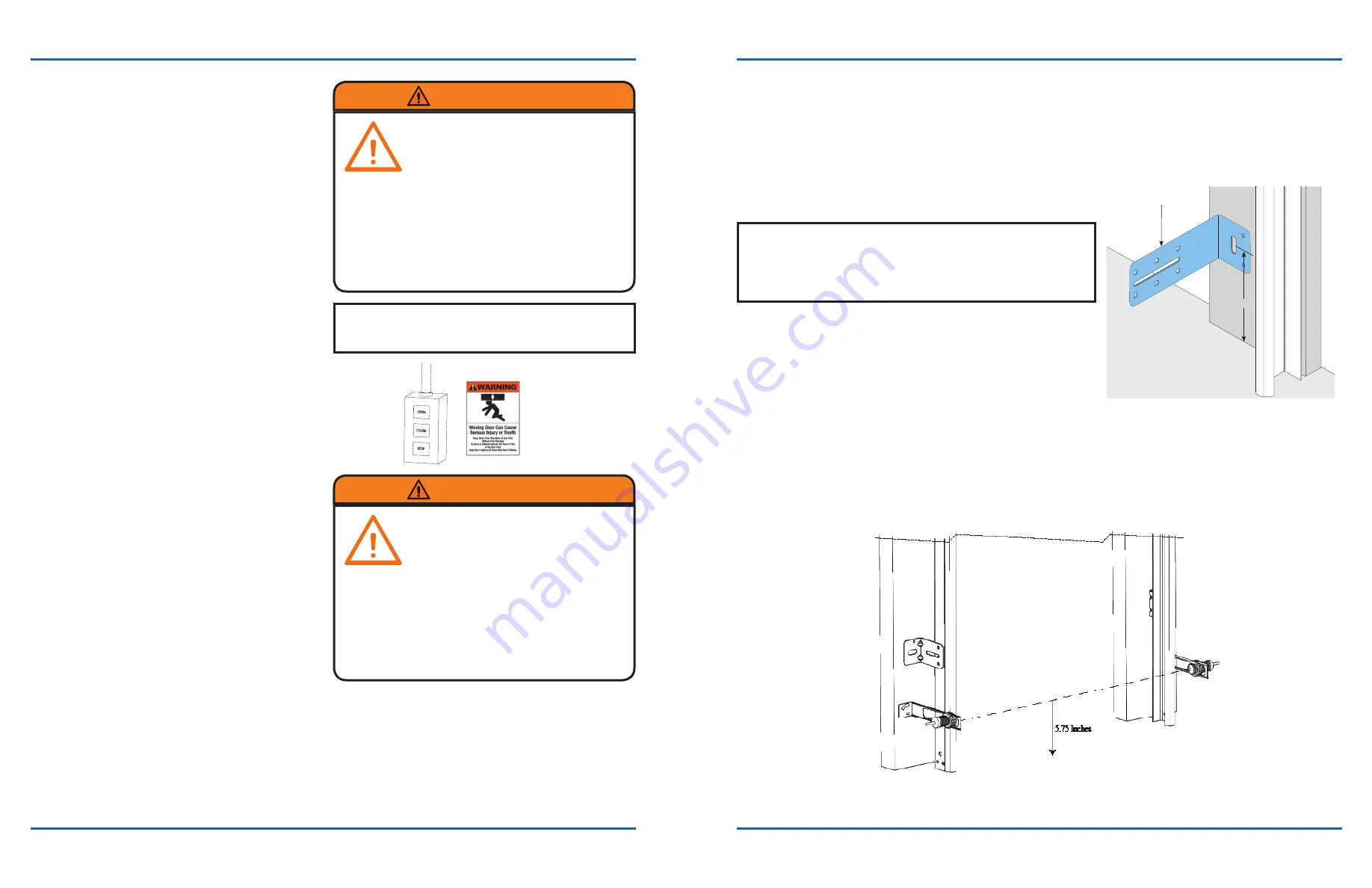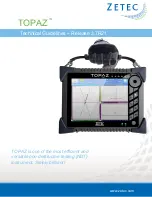
WIRING TYPE
MDJ, MDJH, MDJB, and MDJBH models are equipped
with the LX900 board (programing and operation, page
11, field wiring, page 15). Upon installation the operator
will be in C2 mode (which means only constant pressure
will close the door).
To achieve B2 mode (where a momentary contact can be
used to close the door) an entrapment protection device
must be wired into the beam terminals according to the
wiring diagram. Once the LX900 detects there is no
obstruction it will switch to B2 Mode.
CONTROL STATION LOCATION
All operators are supplied with some type of control
station. Generally a three button station (OPEN/
CLOSED/STOP) is provided. Mount the control station
within sight of the door, at a minimum of five (5) feet
above the floor so children cannot reach it and away from
any moving parts of the door.
RADIO CONTROL
All MDJ series operators have internal antenna’s. LX900
compatible Single button, three button, or OPEN/CLOSE/
STOP (OCS) transmitter(s) are optional accessories.
While in B2 Mode, transmitters will operate the door the
same as a wall control station. Also on all MDJ series
operators, terminal strip is provided on the side of the
electrical enclosure labeled as a 24 Volt Class 2 circuit
and numbered (1,2,3). All standard radio receivers
may be wired to this terminal strip. Single channel
transmitters will then open a fully closed door, close a
fully open door, and reverse a closing door from the radio
transmitter. However, for complete door control from a
remote, a commercial three-channel radio receiver (with
connections for OPEN/CLOSE/STOP) is recommended.
ADDITIONAL ACCESS CONTROL EQUIPMENT
Locate any additional access control equipment as
desired (but so that the door will be in clear sight of the
person operating the equipment), and connect to the
control board in accordance with the LX900 WIRING
CONNECTIONS diagram. Any control with a normally
open (N.O.) isolated output contact may be connected in
parallel with the OPEN button or to the momentary switch
terminals. More than one device may be connected in this
manner. Use 18 gauge wire or larger for all controls.
External Interlock Switch
If an external interlock switch is required on the door, refer to the LX900 WIRING CONNECTIONS diagram for installation.
This switch should have a contact rating of at least 3 amps @ 24VAC. The switch must be wired in series with the STOP
and hoist switch circuit so that the door will only operate while the switch is in its closed circuit state (See wiring diagram
on page 14).
To prevent possible SERIOUS INJURY or
DEATH from a moving garage door:
•
ALWAYS keep remote controls out of
reach of children.
•
NEVER permit children to operate, or
play with remote controls.
•
Activate gate or door ONLY when it can be seen
clearly, is properly adjusted, and there are no
obstructions to door travel.
•
ALWAYS keep gate or garage door in sight until
completely closed. NEVER permit anyone to cross
path of moving gate or door.
To prevent possible SERIOUS INJURY or
DEATH
:
•
Install the control station within sight of
the door at a minimum of five (5) feet (to
prevent operation by children), but away
from the door and its hardware.
•
Install reversing sensors when the 3-button control
station is out of sight of the door or ANY other control
(automatic or manual) is used. Reversing devices are
recommended for ALL installations
•
A reversing edge MUST be installed when a receiver
is used to activate a commercial door opener.
CONTROL WIRING
MDJ, MDJH, MDJB, MDJBH
IMPORTANT NOTE:
Mount warning notice beside or below the push button
station.
WARNING
WARNING
8
MDJ, MDJH, MDJB, MDJBH
9
PHOTO EYE INSTALLATION
1. Make sure that power is disconnected to the system prior to installing the photo eyes.
2. Photo eyes need to be mounted inside the building. They should be mounted on either side of the door and as close
as possible to the door track to offer maximum safety precaution.
3.
Photo eyes should be mounted no more than 6 inches from the floor. Both brackets need to be installed at the same
height to allow them to align.
4.
Select a mounting location 5 inches above the floor to the centerline of the wall mounting “L” bracket. Mount the
bracket to the wall. Repeat this step on the opposite side of the door.
5. Using the wing nuts provided, attach the photo eyes to the “L”
brackets with the arrows pointing up. Do not over tighten.
6. The transmitter and the receiver both have two 22-gauge wires
coming from them. Uncoil the wires from the photo eyes and route
them to the controller. Take one wire from the transmitter and one wire
from the receiver (these wires have no polarity) and twist the stripped
ends together. Repeat on the second wire from each unit. Connect the
wires to the BEAM terminals. Again, polarity is not important.
7. At this time, you can reconnect the power to the operator. The LEDs
on both transmitter and receiver will be lit if installed and aligned
properly; the transmitter has a red LED, and the receiver has a green LED.
8.
If the photo eyes are not aligned, then the green LED on the receiver will be off. To align the photo eyes, you can
adjust the position of the transmitter or the receiver on the slot of the bracket until both LEDs are lit. Tighten the
brackets.
9. To test the photo eye system: open the door to the full open position. Close the door and as the door is closing,
obstruct the beam. The door should stop and reverse to open.
10. Test the photo eye’s function periodically.
PHOTO EYE INSTALLATION
IMPORTANT NOTE:
Identify which side of the garage door is exposed to the most
sunlight. Mount the sending unit (TX) on the side that is exposed
to the most sun. Sunlight may affect the photo sensors and this
orientation will help reduce the effect.
11
Wired Infrared Safety Sensor Bracket Installation
Tools Required: Ratchet wrench, tape measure, power drill, 1/4 inch drill bit, 1/2 inch socket, pencil
IMPORTANT:
BOTH WALL BRACKETS MUST BE MOUNTED AT THE SAME HEIGHT FOR PROPER ALIGNMENT.
IMPORTANT:
IDENTIFY WHICH SIDE OF THE GARAGE DOOR IS EXPOSED TO THE MOST SUNLIGHT.
MOUNT THE SENDING UNIT (UNIT WITH RED LED) ON THE SIDE WHICH IS EXPOSED TO THE MOST SUN.
SUNLIGHT MAY AFFECT THE SAFETY SENSORS AND THIS ORIENTATION WILL HELP REDUCE THE EFFECT.
Wall Mounting Bracket
5”
Note: Use the following steps to install sensors on both sides of the door
Select and mark with a pencil a mounting location no more than 5 inches above the floor to the
center line of the wall mounting bracket.
The safety sensors should be mounted as close
to the door track or inside edge of the door as
possible to offer maximum entrapment
protection. It is very important that both
brackets be mounted at the same height for
proper alignment.
Drill pilot hole using a1/4 inch drill bit. Attach
bracket to wall using provided 5/16 x 1-1/2 lag
screw and nail as illustrated.
In some installations it may be necessary to
attach a wooden spacer to the wall to achieve
the required alignment.
After both brackets are mounted attach sensor
units to brackets using wing nuts. Be sure arrow
on sensors are pointing up.
Arrow on the sensor
pointing up
17
FIGURE 8
FIGURE 9



























